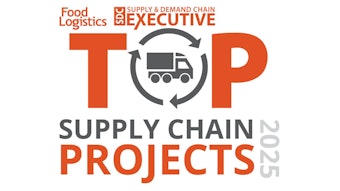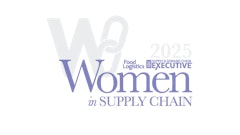
As the U.S. shifts their trade environment under the new Trump administration, third-party logistics providers (3PLs) find themselves in the crosshairs of cross-border freight challenges.
Proposed tariff increases and stricter customs regulations are reshaping the logistics landscape in 2025, compelling 3PLs to adapt their strategies to navigate the turbulence. Luckily, many trends and innovations in transportation, from predictive analytics to collaboration, are available to ease the struggle and find 3PLs more than equipped for the job.
Tariff impacts on trade volume and pricing
Rising tariffs on key imports and exports are expected to increase costs across the supply chain. This has the potential to reduce trade volumes, disrupt established freight patterns and pressure 3PLs to re-evaluate their pricing models.
According to the Bureau of Transportation Statistics (BTS) North American freight data, a long-term trend is emerging between United States, Canada, and Mexico freight trucking, and has been ongoing since 2017. From 2000-2023, the number of trucks from Canada decreased 21.6% from 7,048,128 to 5,526,056 while trucks from Mexico increased 62.6% from 4,525,579 to 7,356,659.
Ryan Williams, VP of solutions and head of cross-border at Coyote Logistics, explains that this growth is only expected to continue trending upwards as companies adjust their freight strategies in the face of geopolitical disruption.
"We’re continuing to see shippers who historically import from Asia to the West Coast – especially those who ship into Mexico – filter inland to mitigate costs and time spent on freight transportation. In Mexico, these companies are setting up new factories closer to the border, and this northbound shift of manufacturing is having downstream impacts on the lanes freight move in from origin points within Mexico and on the makeup of the freight load itself," says Williams.
As the BTS data describes in a smaller, more recent, scope, 2019-2023 saw the number of commercial trucks entering the United States from Mexico rose 14.2% from 6,440,255 to 7,356,659 while trucks from Canada fell 2.7% from 5,681,155 to 5,526,056.
 Trucks at border checkpoint.Achirawee/stock.adobe.com
Trucks at border checkpoint.Achirawee/stock.adobe.com
"As shipping volumes increase in Mexico and the freight market continues to evolve for the foreseeable future, shippers should focus on building strong, long-lasting relationships founded on trust with providers instead of leveraging a large number of carriers," explains Williams. "Avoiding quick, transactional experiences with carriers can help companies ensure their teams maximize business value from the relationship. This will in turn enable them to future-proof their supply chains through reliable and informed collaboration."
Adapting in this landscape means crafting long-term strategies in the face of these predictions. Noel Perry, chief economist for Truckstop, says the key is heightened business environment scanning and with willingness to consider dramatic market changes, i.e., the ability to consider the unthinkable.
"Domestically, the markets are becoming more cyclical, emphasizing managing through the cycles rather than simply adjusting to the latest crisis," Perry explains. "Globally, one must recognize that the great free trade era that encouraged the explosion of global sources is under dire threat. What would American firms do if denied access to Southeast Asian manufactured goods, Persian Gulf oil, or Mexican auto assembly?"
Regulations, border challenges and other constraints
The introduction of more stringent customs requirements in 2025 could extend clearance times and create bottlenecks at key border crossings, such as those along the U.S.-Mexico and U.S.-Canada trade corridors. This not only delays shipments but can eat away at supply chain timelines and increase costs for 3PLs and their customers.
3PLs can adopt proactive compliance measures to include things like:
- Investing in expertise. Developing teams or partnering with specialists who are well-versed in international trade law and customs requirements.
- Technology integration. Leveraging digital platforms that automate document preparation, improve accuracy and provide real-time updates on shipment status.
- Collaboration with authorities. Building stronger relationships with customs officials to ensure smoother clearance processes and quicker resolutions for potential issues.
Mitigating risks beyond the border can also come in the form of insurance, utilizing specialized offers to respond to certain risks posed to the transportation sector.
Jae Lynn Huckaba, associate, and Jorge R. Aviles, counsel, at Hunton Andrews Kurth say different insurance products respond to cross-border risks in different ways. For example, contingent business interruption coverage generally responds to mitigate lost profits resulting from an interruption of business caused by physical damage to a supplier’s property, while cyber insurance generally protects against the costs of digital threats, such as ransomware attacks, phishing or hacking.
The nature of 3PLs offers a reduction in supply chain risks through expertise in areas such as risk management, disaster recovery and often a means to alternative routes. Maintaining competitiveness in the industry means anticipating the worst and utilizing relationships for the better.
Sam Burkhan, CEO of ITF Group, says Mexico's recent decision to end 'border-skipping,' previously used by U.S. e-commerce sellers to bypass tariffs on Chinese goods, may further drive nearshoring and reshoring efforts in 2025. “As a result, national warehouse occupancy rates, averaging 90%, with key regions like Laredo and California already reaching 98%, may tighten, making capacity more challenging to secure. And this is just one element to consider," says Burkhan.
In a recent report by ITS Logistics, key concerns in transportation were highlighted as inflationary pressure, monetary policy uncertainty, global economic uncertainty and consumer confidence.
“Recent data indicates that inflation remains a concern, with the Personal Consumption Expenditures (PCE) price index expected to rise by 2.5% in November, up from 2.3% in October,” says ITS Logistics CFO Stan Kolev. “This upward trend suggests that inflation is becoming more persistent, which may compel the Federal Reserve to maintain higher interest rates for an extended period, potentially dampening economic growth.”
"In the absence of immigration reform, 2025 should be the calmest labor year in the last five due to the slow economic growth. This short-run trend will temporarily stall the steady tightening of U.S. labor markets due to long-standing demographic trends. However, the pressure on immigration along the Mexican border could create major shortages should the Administration succeed in deporting undocumented workers from border supply chains. In addition, the administrative loads and traffic delays that may follow tariffs and immigration programs will lower productivity, a change that could cause labor shortages," explains Perry.
Putting contingencies in place to mitigate risks, whether due to geo-political climate, destructive natural disasters, warehousing constraints or labor woes, gains an edge for shippers. To address these risks, 3PLs should continue exploring alternative modes of transport and diversifying carrier partnerships to increase freight flow.
Technology leads the charge
 Shipping networks connected by technology.Cheewynn/stock.adobe.com
Shipping networks connected by technology.Cheewynn/stock.adobe.com
Real-time visibility platforms provide 3PLs with end-to-end tracking of shipments across borders. These systems integrate tools like GPS, IoT sensors and more, working in junction with predictive analytics tools to anticipate weather patterns and port congestion. This leads to more informed decision making on the 3PLs part to reroute or re-strategize. For scenario planning, leveraging digital twins to simulate scenarios, such as those tariff hikes or port closures due to ongoing strikes, can work to help 3PLs assess potential impacts.
TMS and AI are a hot topic lately with the enhancement of evaluating factors like fuel costs and capacity availability. Even collaborative platforms are working to allow 3PLs ease of communication and information sharing to partners, customers and customs authorities at the border. Each piece of these technologies plays a role in improving cross-border operations regardless of the status of the industry; in the good times, and the bad, investing in technology to improve operations only makes for more efficiency and better marketing.
"This year will accelerate the existing trend in the 3PL space, which is rapidly exchanging people for technology. While the surviving people will be more important, the industry is in the midst of data entry and analysis automation. 3PLs have always been technology dependent. The logistics environment is making them more so," says Perry.
3PLs actively addressing compliance complexities, investigating the use case of digital tools and keeping abreast of the geopolitical uncertainties across borders can turn obstacles into opportunities. Ultimately, it's those who prioritize resilience and agility who set the standard for the industry’s future.




























